I'm working on project where I would like to measure inductance of 4 different springs (to measure weights) using uC - Arduino. I found out that you can do that by measuring frequency of LC circuit and then converting signal to digital using LM339 comparator.
Since you can only do accurate time measurement using Timer1 and its interrupt on pin 8, I thought it would be best to just connect all comparator outputs on LM339 together and using different uC output pins to charge up LC circuits. It all worked fine if only one coil has been connected, but if I connected another one, I got no output from them.
I used modified version of this code: http://codinglab.blogspot.si/2013/02/measuring-inductances-using-arduino.html to read times and calculate frequencies on pin 8. Edit: Principle is you charge one LC and measure the output frequency and then charge another and do the measurement and so on.
I suspect that those LC circuits interfere with each other, but I have no idea how to solve that problem. The circuit that I made:
